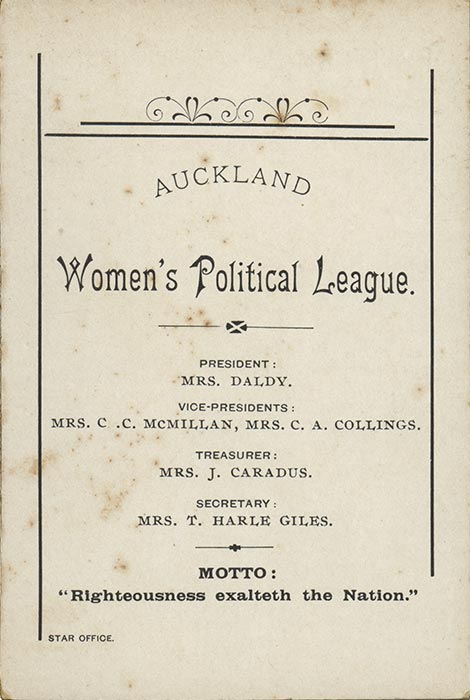This essay written by Raewyn Dalziel was first published in Women Together: a History of Women's Organisations in New Zealand in 1993.
The Auckland Women's Political League (AWPL) was the successor to the local Franchise League, introduced to Auckland from Dunedin by Harriet Morison in June 1892 and taken up by Amey Daldy, the Auckland suffrage superintendent for the Women’s Christian Temperance Union (WCTU), and Annabel Knight, another prominent suffragist. The Franchise League campaigned for the full enfranchisement of women, interpreted by some as the right to vote and by others as the right to vote and to sit in Parliament. Once the vote was won, the league dissolved and re-formed in January 1894 as the Auckland Women's Political League. It survived longer than any of the other organisations arising immediately out of the suffrage campaign, becoming in 1925 a branch of the Labour Party.
The objects of the league, presided over by Daldy, were the election of honest, moral men to Parliament and other public office, the political education of women, the reform of marriage, divorce and custody laws, the elimination of social vice, and the retention of free, compulsory education. Membership was open to women of 'all classes, creeds and conviction'.

Auckland War Memorial Museum Tamaki Paenga Hira,HQ1831(4)-AWPL.
Cover of early Auckland Women's Political League pamphlet. (See pamphlet on Te Ara)
Within a year the league foundered when Daldy opposed the Liberal government's resumption of overseas borrowing and insisted that the league separate itself from party politics. Consequently the league split and the secretary, Eliza Collings, left, along with 60 other members, to form the Auckland Women's Liberal League (AWLL).
The AWPL supported women's rights issues such as the repeal of the Contagious Diseases Act and the right of a wife to half her husband's wage, but opposed many of the liberal trends in social policy. It regarded old age pensions as an impost on the prudent to benefit the improvident, and thought people who had been in prison or a public benevolent institution had forfeited the right to vote.
Amey Daldy was the mainstay of the league through the 1890s, holding the offices of president 1892–99 and 1900 and secretary 1899–1905. She represented the league at the inaugural meeting of the National Council of Women (NCW) and, in 1898, became the NCW's national president. By 1905 Daldy, aged 75, was no longer up to running the league and its monthly meetings ceased.
Two years later, in April 1907, the AWPL was revived with a new president, Clementine Kirkby, and a new secretary, her sister Emily Gibson. The widowed Kirkby had emigrated to New Zealand with her children in 1891. She had formerly been a member of the AWLL and treasurer of the NCW. Gibson, a trained compositor and proof-reader, had also attended NCW conventions, receiving considerable publicity in 1899 when she advocated the unionisation of domestic servants. The AWPL was, however, the main springboard for the political careers of both Kirkby and Gibson. Gibson was secretary 1907–13 and 1914–17, and corresponding secretary through the 1920s.
Before World War I the league's main interests were the cost of living, women's rights and social purity. It supported the right of women teachers to equal pay and opposed the importing of workers, whether British nurses or Asian labourers. Watching the morals of the nation, it demanded that the age of consent be raised, that hotels be closed on Saturday afternoons, that pulp fiction be banned, and that women 'of feeble mind' who bore children be sent to 'farm colonies'. The league also opposed compulsory military service, and when war broke out it protested against the dispatch of troops to Europe, arguing that they should be kept at home to defend New Zealand.
The league regularly advocated women's entry into Parliament, maintaining in 1915 that, if women 'who are the chief sufferers by war' were legislators, 'warfare would soon give way to peaceful arbitration'. [1] It also agitated for the appointment of women police, justices of the peace and jurors.
The league was a small group, with never more than about 35 members in the 1900s. In September 1916 it affiliated to the newly formed Labour Party, and in May 1918 amalgamated with the Women's International League. The combined organisations became known as the Women's International and Political Leagues, and operated as the New Zealand section of the Women's International League for Peace and Freedom. The leagues went into recess in September 1919, re-emerging in December 1920. In the early 1920s they became increasingly radical, stating their objects as the support of 'true internationalism, anti-militarism and the interests of working class women'. [2] Delegates attended Labour Party conferences, and in April 1923 Mollie Lee, wife of Labour MP John A. Lee, was elected president of the leagues. In June 1925 a resolution to become the Auckland Women's Branch of the New Zealand Labour Party was carried unanimously. Amey Daldy would have been shocked.
Notes
[1] AWPL minutes, 10 June 1915.
[2] New Zealand Labour Party Auckland Women's Branch minutes, 7 April 1921.
Unpublished sources
Auckland Women's Political League minutes and other records. 1892-1916. MSS & Archives 2009/6. Special Collections, University of Auckland Libraries and Learning Services. https://archives.library.auckland.ac.nz/repositories/2/resources/850
Dreaver, K. R., 'Women's Suffrage in Auckland 1885-1893', MA research essay, University of Auckland, 1985
New Zealand Labour Party Auckland Women's Branch minutes 1917-1925, ATL.
Woods, Helen, '"A House divided against itself cannot stand"', MA research essay, University of Auckland, 1983

Community contributions